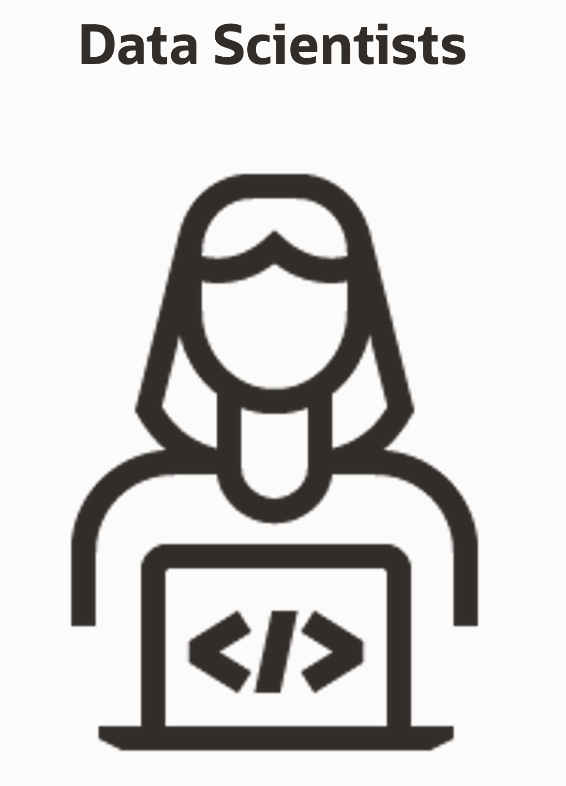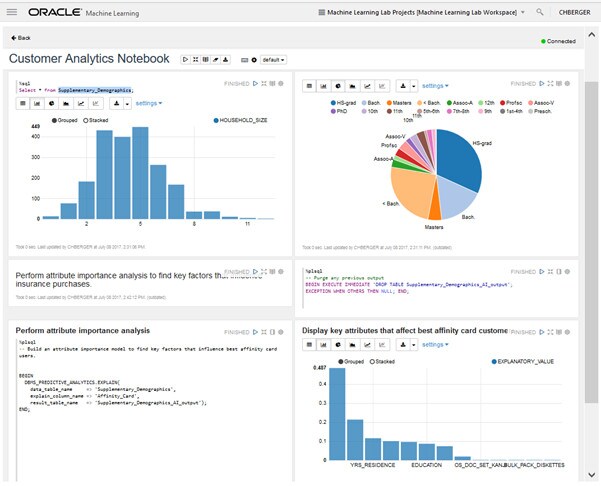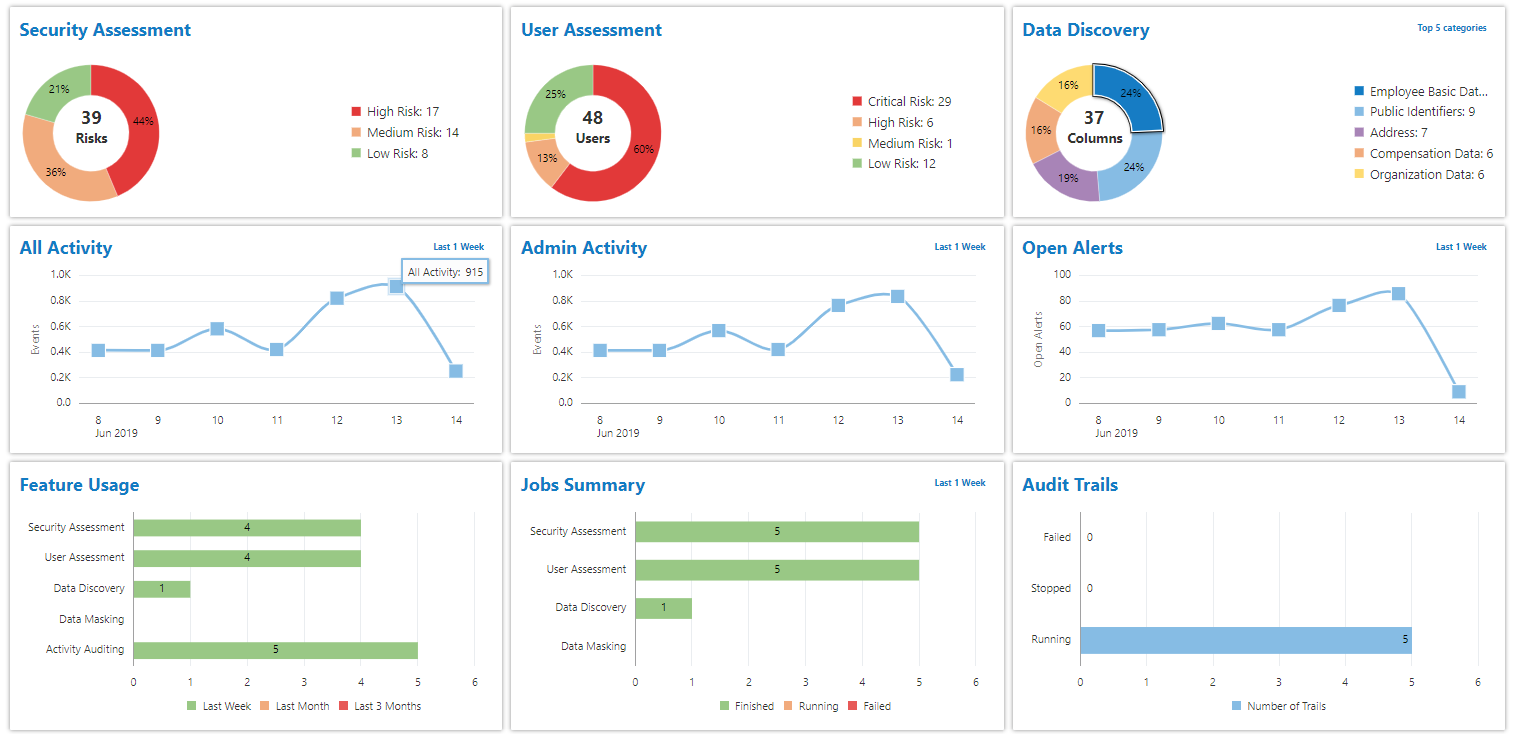Oracle Cloud-Native
Data Warehouse Technologies
Utilize data warehousing on-premises or in the cloud. Data Warehousing and analytics technologies such as zero-downtime scaling, Autonomous Data Guard, Oracle Database In-Memory, Oracle Multitenant, machine learning, spatial and graph capabilities enable analytics teams to deliver deeper richer insights in less time.

VIDEO: Autonomous Data Warehouse – Under The Hood, How It Works
Oracle VP, George Lumpkin discusses difference between automation vs. autonomous and delivers a deep dive into hands-free data warehousing on Oracle Cloud
LINK: Global Leaders Program
An elite program for our global big data warehousing and cloud customers. It gives our customers an open communication channel for providing product insights, solution planning and implementation reviews between Oracle Development and customers who are at the leading-edge of big data warehousing initiatives

VIDEO: New Autonomous Data Warehouse Innovations
Andrew Mendelsohn, Executive Vice President, Oracle Database Server Technologies, talks about the latest innovations in the industry’s first and only self-driving cloud data warehouse

Shining a Light on the Hidden Data Economy
Considering enterprise data in terms of supply, demand, and transaction costs enables companies to craft more effective data strategies and increase return on data capital. Join us to learn how the unique capabilities of Oracle's cloud and database technologies can put these ideas into action.
There are many benefits in being part of the Oracle Global Leaders program - get expert guidance and support for developing leading-edge data management strategies.
Empowering Business Innovators With Self-Servive Cloud Data Ecosystem



Select data from your local computer, from tables in other databases, or from cloud storage and then add that data to new or existing tables or views in, or link to the data from, your Oracle Autonomous Database.
Click on Data Load button for more information.
|
|
Simple "drag-and-drop" data transformation built-in recognized leader ELT tool Oracle Data Integrator.
Click on Transform button for more information.
Aims to describe the business entities that are derived from data in an Oracle Autonomous Database schema or other sources; in this way, you can create a semantic model on top of your data identifying hierarchies, measures and dimensions.
Click on Business Model button for more information.
Crawls over business model and discovers hidden patterns, anomalies and outliers in your data.
Click on Data Insights button for more information.
 Catalog:
Catalog:Use the Catalog page to get information about the entities in your database, their data sets, how they were created, statistical analysis of each entities data, and the impact that changing the source of an entity may have on other entities.
Click on Catalog button for more information.
 Graph Analysis:
Graph Analysis:Oracle Autonomous Database includes Graph Studio, with one-click provisioning, integrated tooling, and security. Graph Studio automates graph data management and simplifies modeling, analysis, and visualization across the graph analytics lifecycle.
Click on Graph Analysis button for more information.
 Spatial Analysis:
Spatial Analysis:Spatial allows developers and analysts to get started easily with location intelligence analytics and mapping services. It makes it easy to manage different types of geospatial data, perform hundreds of spatial analytic operations, and use interactive map visualization tools.
Click on Spatial Analysis button for more information.
 Machine Learning:
Machine Learning:Oracle accelerates machine learning (ML) with powerful algorithms that run inside the database so you can build and run ML models without having to move or reformat data. Data scientists can leverage Python, R, SQL, and other tools to integrate ML capabilities into database applications and deliver analytics results in easy-to-use dashboards.
Click on Machine Learning button for more information.
 APEX:
APEX:Using APEX, developers can quickly develop and deploy compelling apps that solve real problems and provide immediate value. You won't need to be an expert in a vast array of technologies to deliver sophisticated solutions. Focus on solving the problem and let APEX take care of the rest.
Click on Low Code button for more information.
 Data Catalog:
Data Catalog:Oracle Cloud Infrastructure (OCI) Data Catalog is a metadata management service that helps data professionals discover data and support data governance. Designed specifically to work well with the Oracle ecosystem, it provides an inventory of assets, a business glossary, and a common metastore for data lakes.
Click on Data Catalog button for more information.
 OCI Object Storage:
OCI Object Storage:The OCI Object Storage service is an internet-scale, high-performance storage platform that offers reliable and cost-efficient data durability. It can store an unlimited amount of unstructured data of any content type, including analytic data and rich content, like images and videos.
You can safely and securely store or retrieve data directly from the internet or from within the cloud platform.
Click on Object Storage button for more information.
 Data Safe:
Data Safe:Data Safe empowers organizations to understand data sensitivity, evaluate data risks, mask sensitive data, implement and monitor security controls, assess user security, and monitor user activity—all in a single, unified console. These capabilities help to manage the day-to-day security and compliance requirements of Oracle Databases, both on-premises and in the cloud.
Click on Data Safe button for more information.
|
Learn how to build a data warehouse faster in the cloud. |
Learn how to load data faster in the cloud. |
Upgrade and/or migrate your existing data warehouse today
Upgrade to the latest Oracle Database technology to benefit from market-leading performance, availability, analytics and security. Migrate your data warehouse to Oracle Cloud Infrastructure to combine low cost with high performance.
Why Choose Oracle For All Your Data Warehouse Needs
Oracle is #1
Oracle Autonomous Database scores highest in all Use Cases in 2020 Gartner Critical Capabilities for Cloud Database Management Systems for Operational Use Cases
Smarter, faster analytic queries
Database In-Memory delivers speed-of-thought processing for sophisticated analytic queries. Database In-Memory implements leading-edge columnar data processing to accelerate your data warehouse analytics by orders of magnitude. Answers that used to take minutes to obtain are now available instantly. Questions that you used to dream about asking can now be quickly and easy answered.
Easier, faster management
Oracle Multitenant is the architecture for the next-generation data warehouse in the cloud. It delivers easier consolidation of data marts and data warehouses by offering complete isolation, agility and economies of scale. Oracle Multitenant offers additional benefits by providing a fast and efficient management framework for delivering sandboxes and data discovery platforms within the overall Oracle Big Data Management System.
Consistently high performance
As data warehouse grows with Oracle Partitioning which enhances the manageability, performance, and availability of large data marts and data warehouses. It increases query performance by only working on the data that is relevant, improves availability through individual partition manageability and decreases costs by storing data in the most appropriate manner.
Temperature-based data optimization
Made possible with Automatic Data Optimization (ADO), which allows you to create policies for smart data compression and data movement making it possible to implement storage and compression tiering. ADO works in conjunction with Oracle Partitioning.
Optimized Hardware
Oracle Database is able to efficiently leverage all hardware resources - multiple CPUs, multiple IO channels, multiple storage units, multiple nodes in a cluster. The Oracle Optimizer can automatically decide if a query should run in parallel and the degree of parallelism to use based on the resource requirements of the statement.
Deployment options to fit your needs
At your location

Run Oracle Database at your own location on your own hardware. Or, use Oracle Exadata in your data center for best performance, flexibility, and robustness.
Oracle Cloud at your location

The best platform for your data warehouse projects, delivered securely behind your firewall and managed by Oracle.
Oracle public cloud

Benefit from the computing power, physical storage, and tooling in the cloud that simplify routine database management operations by using Oracle’s highest-performance engineered system, designed specifically for enterprise-scale cloud workloads.
Learn more about Oracle's unique data warehouse features
Get more in-depth details...
Partitioning
Partitioning is powerful functionality that allows tables, indexes, and index-organized tables to be subdivided into smaller pieces, enabling these database objects to be managed and accessed at a finer level of granularity. |
 |
Analytic SQL
The in-database analytical functions and features that are embedded inside the Oracle Database can be used to answer a wide variety of business problems. |
 |
Query Optimizer
The Optimizer is one of the most fascinating components of the Oracle Database, since it is essential to the processing of every SQL statement. |
 |
In-Memory
Database In-Memory provides a unique dual-format architecture that enables tables to be simultaneously represented in memory using traditional row format and a new in-memory column format. |
 |
Machine Learning
Oracle Machine Learning accelerates the creation and deployment of machine learning models for data scientists using reduced data movement, AutoML technology, and simplified deployment. |
|
Big Data SQL
Fast, secure SQL queries over all your data. Extends Oracle SQL processing to and the security of Oracle Autonomous Database to all your data. |
 |
Spatial
SpatialOracle Spatial allows developers and analysts to get started easily with location intelligence analytics and mapping services. Organizations can manage different types of geospatial data, perform hundreds of spatial analytic operations, and use interactive map visualization tools. |
 |
Graph
Graph allows analysts and developers to perform fraud detection in banking, find connections and link to data, and improve traceability in smart manufacturing, all while gaining enterprise-grade security, ease of data ingestion, and strong support for data workloads. |
 |
Data Safe
Data Safe is a unified control center which helps you understand the sensitivity of your data, evaluate risks to data, mask sensitive data, implement and monitor security controls, assess user security, monitor user activity, and address data security compliance requirements. |
|
Parallel Execution
Parallel execution is a commonly used method of speeding up operations by splitting a task into smaller sub tasks. |
 |
Data Warehouse Workshops
Get hands-on experience with free workshops on Oracle LiveLabs...
Autonomous Database
Quick Start Workshop
The labs in this workshop walk you through all the steps to get started using the Oracle Autonomous Database Serverless (ADB-S). You will provision a new ADB instance, load data from the object store and troubleshoot data loads, query external data residing on the object store, and create rich data visualizations using Oracle Analytics Desktop. |
 |
Important Tools for Everyone Using Oracle Autonomous Database Workshop
The purpose of this workshop is to introduce you to the suite of data tools built into the Oracle Autonomous Database for Data Warehousing. The workshop is designed to be used alongside your own cloud account (paid or Bring-Your-Own-License) or you can register and claim free trial credits which provides up to 3,300 hours of cloud time, and 2 TB of storage, which is more than enough time and storage space to run this workshop. |
 |
Oracle MovieStream
Workshop
Oracle MovieStream is a fictitious movie streaming service. They face challenges that are typical to many organizations across industries. |
 |
Get Started with Graph Analytics on Oracle Autonomous Database Workshop
This workshop covers how to load data in CSV files into the database and introduces key graph data modeling and analysis concepts and the interactive Graph Studio for working with graphs in an Autonomous Database. It shows you how to use graph queries to find circular payments which may indicate fraudulent transactions. You will load data from CSV files containing (artificial) Account and Transaction information. Then create a graph and finally query it and visualize the results. |
 |
Introduction to Machine Learning Algorithms on ADB
In this lab, you will use the Oracle Machine Learning (OML) SQL notebook application provided with your Autonomous Data Warehouse. This browser-based application provides a web interface to run SQL queries and scripts, which can be grouped together within a notebook. Notebooks can be used to build single reports, collections of reports, and even dashboards. OML provides a simple way to share workbooks and collections of workbooks with other OML users. |
 |
Introduction to Oracle Spatial Studio Workshop
In this workshop you will explore the features of Spatial Studio for self-service spatial analysis and visualization. Using datasets of traffic accidents, police stations, and police station service areas, you will load and visualize spatial data, and analyze their spatial relationships as shown below. |
 |
Want to learn more - use our guided learning paths
Quick Start
Perform basic tasks on ADB. Everything from provisioning to loading data to writing queries.
Visualizing Data
Working with data visualization tools such as Oracle Analytics Desktop
Machine Learning
Use Oracle Machine Learning SQL Notebooks to build reports, dashboards and workbooks on Autonomous Database.
Developing Apps
Create an APEX workspace then learn how to extend it using spatial, machine learning and security features.
Managing and Monitoring
Provision an Autonomous Database, load sample data and manage and monitor the environment using the Service Console.
Customer Stories
Learn how Oracle customers in the GL program are using Oracle's data management platform to transform their businesses by helping them to reduce costs and complexity and allowing them to engage with their data in new smarter, better ways.
Oracle Analytics
Oracle Analytics
Oracle Autonomous Database
Oracle Cloud Infrastructure
Oracle Analytics
Oracle Analytics
Oracle Cloud Infrastructure
Oracle Cloud Compute
Oracle Cloud Infrastructure Storage
Oracle Cloud Compute
Oracle Analytics
Oracle Cloud ERP
Oracle Analytics
Oracle Analytics Cloud
Oracle Analytics
Oracle Machine Learning
Oracle Analytics
Oracle Cloud Infrastructure
Oracle Analytics
Oracle APEX
Oracle Analytics
Oracle Analytics
Oracle Advertising and CX
Oracle Analytics
Oracle Cloud and Azure Interconnect
Oracle Analytics
Oracle Cloud Infrastructure
Oracle Analytics
Oracle Cloud Infrastructure
Oracle Analytics
Oracle Cloud Infrastructure
Oracle Cloud EPM
Oracle Cloud Infrastructure
Check out the latest new features in Autonomous Database..
Get started with Oracle Database
Try Oracle Cloud Free Tier
Build, test, and deploy applications on Oracle Cloud for free.
Run a workshop
Run a wide variety of labs and workshops and experience our best technology live.
Get certified
Access online training and certifications for Oracle Database cloud services.
Contact sales
Interested in learning more? Contact one of our industry-leading experts.
 Autonomous Data Warehouse:
Autonomous Data Warehouse: